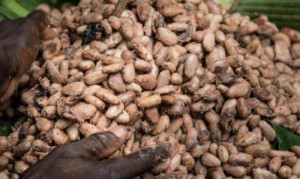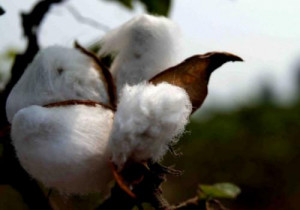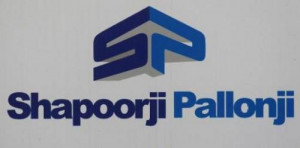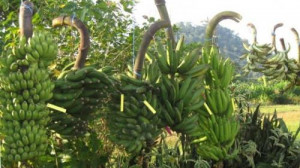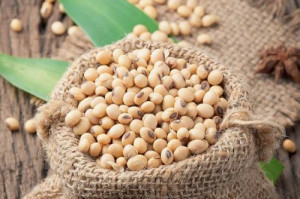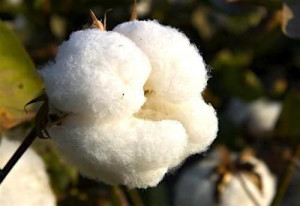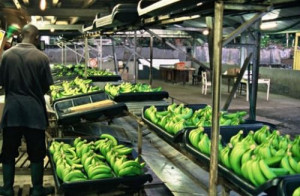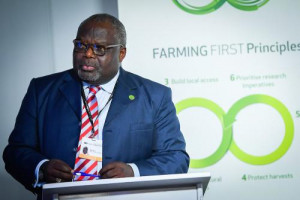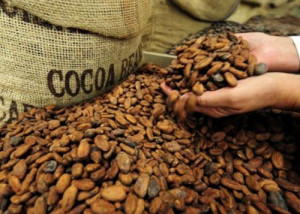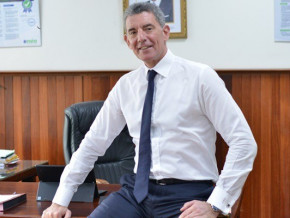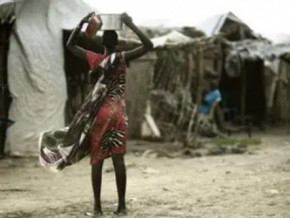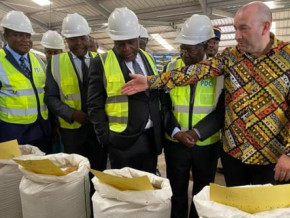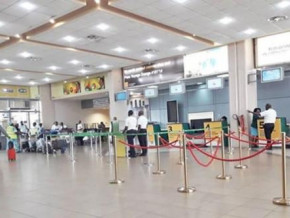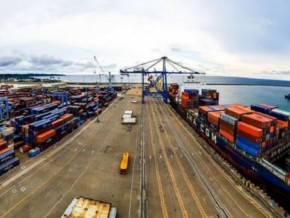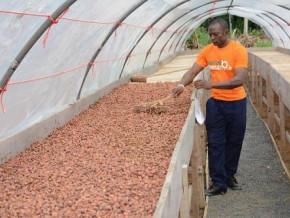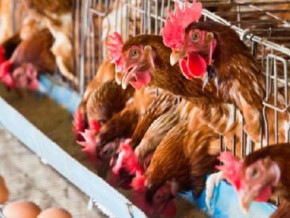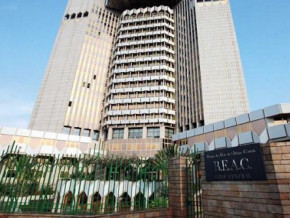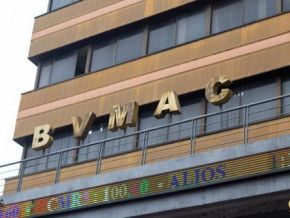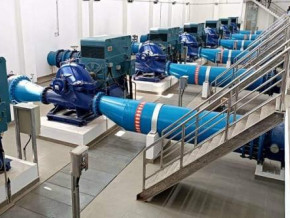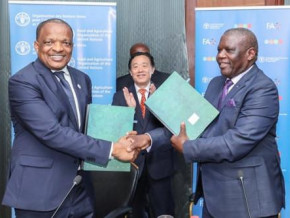
Cameroon: Cocoa price drops to just over XAF900 per kg, after having reached XAF1,000 in October 2018
As at December 28, 2018, cocoa beans were still traded at a maximum price of XAF1,000 per kg, like during much of October 2018.
Since then, including over the rest of the market days since the 2018-2019 campaign started, prices have stabilized between XAF910 and XAF975, according to daily surveys carried out as part of the Sector Information System (Sif).
Let’s recall that although these prices are far below the XAF1,500 per kilogram collected a few years ago, Cameroonian cocoa farmers remain better paid than their Ivorian and Ghanaian counterparts who receive barely over XAF800 per kilogram of beans.
BRM
Sodecoton revokes decision to use GMO cotton to boost output
Cameroon’s cotton development company (Sodecoton) which, until recently, said it will introduce GMO cotton to boost its production has now revoked this decision.
“The experimentation of genetically modified cotton was conducted for a research purpose. This research stopped during the 2017-2018 crop year, in accordance with the authorization received from the Ministry of Environment, Nature Protection and Sustainable Development (Minepded), on the implementation phase in an open environment. As this experimental phase was completed since April 2018, and so far no
regulation has been obtained from the public authorities to continue this activity, Sodecoton has put an end to this research component,” explains MD Mohamadou Bayero Bounou.
The latter points out that instead of introducing GMOs into cotton cultivation, Sodecoton and its research partners, the Institute of Agricultural Research for Development (Irad) and the Centre for International Cooperation in Agricultural Research for Development (CIRAD), have developed conventional varieties that are not genetically modified but high-yielding.
These varieties, the manager said, “have a high field yield potential of up to 3.5 tons/ha, particularly for the IRMA Q302 variety (grown throughout the cotton zone), which has good agronomic and technological characteristics. A well-developed and administered technical itinerary and a reasonable insecticide treatment program, make it possible to properly manage pest pressures in the cotton zone and achieve good production. As a result, the conventional non-GM varieties, popularized by Sodecoton at this time, are fully satisfactory, both for the producers and for the company”.
“Sodecoton has no intention of opting for genetically modified cotton to achieve its cotton production objectives,” the MD concluded, stressing that the average yields of 1,400 kg/ha of seed cotton produced in recent years in Cameroon, are already the “best yields in rainfed farming in all of Africa”.
Thanks to these new varieties, Sodecoton aims to achieve a production of nearly 300,000 tons during the current cotton season, well above the 109,000 tons produced in 2009; a poor performance that prompted the company, in collaboration with Bayer CropSciences, Irad, CIRAD and the National Biosafety Committee (Cnb), to launch tests for genetically modified cotton during the 2012-2013 agricultural season.
Brice R. Mbodiam
Cameroon: Indian Shapoorji Pallonji plans a 10,000-ha hydro agricultural scheme in the Far North
As part of a MoU signed Dec 12 in Yaoundé with the Cameroonian government, India’s Shapoorji Pallonji and Company Private Limited will set up a hydro-agricultural development over 10,000 ha in Logone Birni district, Far North region.
The project plans the development of areas dedicated to rice cultivation and the construction of a paddy rice husking unit as well as capacity building for rice growers.
It is included in a component of the government’s 3-year Emergency Plan to Accelerate Growth (Planut) which aims at developing 120,000 ha of hydro-agricultural schemes, we learnt.
BRM
An open letter calling African producers for a fair price of banana to the supermarkets
While the international controversy over the purchase price of banana boxes by supermarkets in 2019 has been growing for several weeks, we, African fruit producers, want to express our solidarity with the approach of our Latin American colleagues and competitors and, in our desire to move towards a fairer world and trade, draw attention to the continued deterioration in the conditions under which our fruits are purchased. By asking for a further decrease of nearly 9% in the purchase price of banana boxes in 2019 and even more decline in the price of pineapples, supermarkets demonstrate their lack of understanding of fruit value chains and indifference to the socio-economic challenges of the world's fruit producing regions, a situation which is too common in the sector.
We solemnly wish to join this call from our Latin American colleagues and competitors because we share with them this concern to see the sustainability of fair and sustainable economic models, taking into account the interests of all stakeholders, rather than a perpetual spiral of blind competition. A fair purchase price for bananas must make it possible to recover the cost elements that contribute to and to promote an equitable sharing of the fruits of labour. It also needs to give to its actors the resources to invest in the transformation and continuous adaptation of their integrated economic, social and environmental model.
The Banana industry leads investments in African rural communities through education, health and housing infrastructures and promotes on a continuing basis the pursuit of good cultural practices. In this way, we contribute to sustainable and inclusive economic growth that truly benefits all stakeholders.
However, supermarkets do not seem to be concerned about these crucial aspects in their supply policy for bananas and other fruits. Yet consumers, who are first and foremost citizens, are increasingly sensitive to the societal issues related to the products they buy. In addition, public authorities, whether European or African, are committed to building together the foundations for sustainable and shared growth between the two continents.
By constantly driving prices down, supermarkets have the power to precipitate the destruction of an African industry that creates wealth and jobs in Côte d'Ivoire, Cameroon, Ghana and other countries on the continent. In Côte d'Ivoire, Cameroon and Ghana, the banana industry provides more than 28,000 direct jobs and 50,000 indirect jobs, with a considerable impact on the development of rural areas. For young people and women in these regions, the banana industry represents a rare opportunity to access unskilled and skilled jobs, offering decent pay and opportunities for professional advancement in their own countries without having to resort to the pursuit of greener pastures in Europe and elsewhere.
This problem, which affects the world's largest banana producers in Latin America, is even more acute for us, small-scale producers, whose models are more sensitive to price variations. These pressures lead to a continuous squeeze on market share and threaten the survival of any diversity in competition and choice for consumers of bananas every day.
Excessively low prices are by no means not fair prices, and citizens and public authorities are the first to be aware of this. That is why we call on all stakeholders - public authorities, banana companies, supermarkets, consumers - to sit down around a table and agree together on a fairer, more sustainable and more humane price.
It is through common sense initiatives on key issues that we can all do our part to support good business models, reduce the widening of inequalities and the North-South divide and enable a more equitable world to emerge.
The signatories
Mr. Joseph Owona Kono, President of Afruibana
Mr. Jean-Marie Kakou Gervais, Vice-President of Afruibana
Mr. Anthony Blay, Vice-President of Afruibana
Cameroon: IDB to pump XAF64.2bn in cotton and soybean
The Islamic Development Bank (IBD), via its specialized body International Islamic Trade Finance Corporation (ITFC), is signing in coming weeks a Murabahah loan agreement (contract with a known profit margin agreed between the parties) with Cameroon.
The Cameroonian Minister of Economy, Alamine Ousmane Mey, who was empowered by a presidential decree on 10 December to sign this contract, will secure an amount of €98 million euros, about CFA64.2 billion.
The money will be used to purchase agricultural inputs (fertilizers, pesticides, herbicides, etc.), cotton seed and soybeans. Output will be sold on local market, official sources said.
ID's support could thus revive a Cameroonian industrial giant namely the national cotton development company (Sodecoton), which underperformed in the soybean segment in 2017, as the soybean oil did not succeed in positioning itself on the local market. Plus, the avian influenza outbreak put pressure on soybean meal marketing during the period.
S.A
Cameroon’s cotton output forecasted to reach 300,000t in 2018-19, first time in at least 5 years
The Cotton Development Company (Sodecoton), leading agro-industrial company in Cameroon’s northern part, is targeting a production of 295,000 tons of cotton during the current 2018-19 campaign, authorized sources within the company said.
This figure roughly corresponds to the production level in 2014; the year after which national cotton output dropped under 290,000 tons sometimes hardly reaching 250,000 tons. A situation motivated by combined effects of lower global prices, losses due to cotton wetting and the marketing of local cotton in Nigeria, where prices were often considered more profitable by Cameroonian producers.
Thanks to a stimulus package, set in recent years, which has seen the renovation of rolling stock that improved field-to-factory transport (thus avoiding cotton wetting), and the rehabilitation of production equipment, which has enabled the machines to run at 90% of their capacity (compared to around 50% previously), Sodecoton now sees a boom in production.
With the success of this recovery plan thanks to which Sodecoton returned into profit in 2016-2017 (XAF4.3 billion), after three gloomy years, with a total of XAF35.6 billion loss, the company aims to increase production to 400,000 tons in 2021, then to 600,000 tons by 2025.
To this end, Sodecoton plans to introduce transgenic cotton (GMOs) in Cameroon. Testing phase started in 2012 and results are expected this year 2018. Let’s recall that the company already launched in 2015 a series of public consultations in the Far North region to assess producers’ view on introducing GMO cotton.
Brice R. Mbodiam
Cameroon exported 17,137 tons of banana in November 2018
Cameroon’s banana shipments reached 17,137 tons in November 2018, the national banana association (Assobacam) said.
Of this volume, Société des Plantations du haut Penja, local branch of Marseille fruit company, exported 15,821 tons, 10 times more than Boh Plantations which shipped only 1,316 tons.
Let’s mention that since September 2018, Cameroon Development Corporation (CDC) has exported no bananas due to the Anglophone crisis-related violence that forced the company to shut down production sites; sites that became training camps for separatists, according to a report from the Cameroonian employers group (Gicam).
BRM
Cameroon: Port of Kribi to take part in Cocoa-Coffee Revival Plan
The Autonomous Port of Kribi (PAK) is organizing November 29-30 a workshop with cocoa-coffee players to discuss ways to stimulate a sector in crisis.
Actions to be carried out, says PAK’s MD Patrice Melom (photo), include the valorization of the industry’s potential by assessing the market size and volumes based on the segmentation of products (beans, cocoa powder and butter), the identification and referencing of all actors in the cocoa-coffee value chain, starting from bean production to processing.
According to Mr. Melom, this is not just a simple marketing offensive for a port that is looking for customers but a fundamental approach that consists, for PAK, in being part of an overall effort and a global dynamic to stimulate the country's general productivity, through the gradual reversal of its trade deficit.
This commitment by the autonomous port of Kribi comes in a context where the cocoa-coffee sector is experiencing some difficulties. Indeed, only 23,413 tons of cocoa beans were exported through the port of Douala at the end of May 2018, two months before the end of the 2017-2018 cocoa season. This reflects a decline by 10% compared to the 249,573 tons exported over the same period during the 2016-2017 cocoa season.
The core reason of this drop in exports is the violence due to the Anglophone crisis mainly in the southwest which is one of the largest bean production basins in Cameroon.
Cocoa is a key industry in Cameroon which is the world’s fifth largest producer of the crop. The sub-sector is the country’s second largest export item, after oil with just over CFA400 billion as annual revenues.
S.A
Hope Sona Ebai: The strategy we worked on aims to make Cameroon a visible player on the cashew market five years from now
Well known in Africa’s cocoa industry, the head of Globalru-Urban Consultants Inc, based in Ghana, is one of the experts who elaborated Cameroon’s national development strategy for the cashew sector. Here, he discusses opportunities that the sector holds for the Cameroonian economy.
Business in Cameroon (BIC) : Following the elaboration of the national strategy to develop value chains of the cashew sector in Cameroon, what is your review of the industry ?
Hope Sona Ebai (HSE) : Cameroon’s cashew industry is still at the embryonic stage. It is true that cashew trees have been planted in the country since 1975 but the sector is yet to be fully developed, from production to processing, including production and distribution of improved seeds.
BIC : In Sanguéré, in the North, there is a plantation of more than 100 hectares that dates back to the 70s. So how is it that the sector hasn’t taken off in so many years ?
HSE : At the time, cashew trees were planted only to reforest. I am well acquainted with the Sanguéré project as I had just returned to Cameroon after my studies abroad when it was launched. It was funded by the National Fund for Rural Development –FONADER. So, the fact was that even if cashew was consumed by the people, it was not seen as an agricultural commodity. However, today, with a rising demand for cashew nuts in Niger and exporters flooding production areas, the sector is now considered a profitable one.
BIC : Cashew trees which produce cashew nuts grow in specific agro-ecologic zones. In Cameroon, where are the main production basins ?
HSE : Identified basins are mostly in the far-North, Adamaoua, the North, the East, part of the Central region, in the department of Mbam which has a dry weather to be exact. Well, cashew grows in hot regions, so the more the rain, the less the yield.
BIC : Some people wish to start growing the crop in Cameroon but have to deal with the lack or unavailability of seeds. How does the national development strategy plan to overcome these challenges?
HSE : What should be done is plan large scale production of seeds since the sector cannot be truly developed with backyard plantations only. For example, to get 10,000 tons of cashew nuts per year, 11 million seedlings are needed. We must therefore produce high-yield seeds since there will also be losses to take into account. For cocoa for example, seeds’ mortality rate reach 35% for traditional seeds.
BIC : Currently, the Agricultural Research Institute for Development (IRAD) is carrying out a program that aims to produce 10 million cashew seeds by 2021. Are these seeds efficient, genetically ?
HSE : Unfortunately, I do not know anything about the genetic composition of these seeds since I don’t know their origin. From what I know however, IRAD must first genetically characterize the seeds and then pick those that are suited for agro-ecologic zones where cashew can be grown. It will take some time and that is why those in need of the seeds have to be a little patient. Even if we import seeds from West Africa, we first need an adaptation assessment of Cameroon’s micro-climates.
Seeds that are currently distributed don’t surely ensure optimal yields. This is done to get farmers interested in the crop, get them to fully engage in the sector, while implementing actions that will help obtain more interesting yields.
BIC : In Côte d’Ivoire, cashew is known as “grey gold”, due to its impact on economic growth of rural areas. What economic assets could this sector offer in Cameroon ?
HSE : I believe cashew is an agricultural industry that has so much more to offer rural areas, beyond revenues. For example, in cotton-farming zones in the north, cashew is an additional source of revenue, besides cotton. Today, Côte d’Ivoire is far more advanced in this sector but it started just like us now. However, after five to seven years, Ivorians noticed that some cashew seeds were not good varieties. That is why we must be careful and provide our research institutions with adequate means to take a good start.
BIC : In West Africa, cashew-farming is well integrated in populations’ habits and helps farmers generate significant revenues. However, in this region, processing is a bit ignored. In Cameroon, what does the cashew sector national development strategy plan in this regard ?
HSE : Under the national strategy, the whole sector is taken into account, both production and processing. Actually, in this regard, a major fair will take place in Côte d’Ivoire this month, November 2018, where processing equipment will be showcased. Actors of the Cameroonian cashew industry will attend the event and will be able to see and appreciate available products and determine what fits best their expectations.
BIC : Just like it is the case with cocoa, we might end up in a situation where small scale farmers are excluded from the processing chain because they lack means to purchase equipment, unlike major players…
HSE : Today, in the cocoa industry, we have small equipment that can fit in a room. This is also possible in the cashew sector. With technology evolving, there are more and more processing equipment that meet small scale farmers’ needs.
BIC : In terms of agro-industrial development in Africa, one of the main challenges is the difficulty to access financing. Once again, what does the national development strategy plan for in this regard ?
HSE : Indeed, the strategy looks at this issue. We have exchanged on how to build bankable projects and attract investments in the sector, both from banks, States and foreign investments as well.
BIC : In your estimates, when could Cameroon become an actual cashew producer, if the national development strategy for the sector is effectively implemented ?
HSE : The strategy we worked on aims to make Cameroon a visible player on the cashew market five years from now, by 2023 that is. The emphasis here is becoming visible, no more for the moment.
Interview by Brice R. Mbodiam
Cameroon: Export revenues fell by 16.8% in H1 2018, crippled by cocoa-coffee sector
Over the first six months of 2018, Cameroon’s export revenues totaled CFA794.6 billion for 2.5 million tons of goods shipped. The figure reflects a decline by 16.8% compared to the same period in 2017, the National Statistics Institute (INS) said.
Despite a decrease in revenues from the sale of crude oil (-33.8%), raw aluminum (-32.8%) and raw rubber (-33.1%), the main driver of this poor performance is the cocoa-coffee sector.
According to INS, over the period reviewed, cocoa export revenues slumped by 13.4% coupled with a bigger decline for by-products such as paste and butter (-89.4% and -90.4% respectively). Meanwhile, coffee export revenues fell by 30.1%.
This decline in overall export earnings, particularly for cocoa, is primary the consequence of unrest in Anglophone regions which hampers the activities of Telcar Cocoa (U.S. Cargill’s local trader), a company which generally accounts for 30% of Cameroon’s bean exports.
Let’s however mention the improvement in the local processing sector, in recent years. Out of an officially estimated national marketed production of 253,510 tons during the 2017-2018 season, Cameroon locally processed 53,494 tons of beans, an increase by more than 20,000 tons compared to the previous year.
In need to boost the national processing capacity, a new unit (Atlantic Cocoa) with a capacity of 48,000 tons, expandable to 64,000 tons, will be commissioned at the end of 2018 in the industrial zone of the deep-water port of Kribi, south region. Cameroon could reach “a processing capacity of 130,000 to 150,000 tons over the next three years,” said the trade minister Luc Magloire Mbarga Atangana.
Brice R. Mbodiam
Mags frontpage
- Most read 7 days
- shared 1 month
- read 1 month


